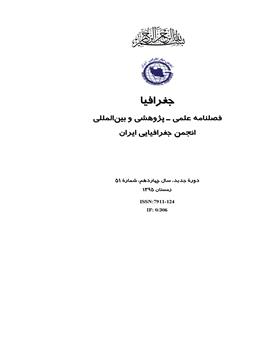تحلیل همدید بارش های حدی و فراگیر در کرانه های غربی خزر با تأکید بر الگوهای فشار تراز دریا
محورهای موضوعی :
1 - دانشگاه پيام نور
کلید واژه: اقلیم¬, شناسی همدید, الگوی گردشی, بارش, رویکرد محیطی به گردشی, فشار تراز دریا, کرانه¬, های غربی خزر,
چکیده مقاله :
در این پژوهش به منظور تحلیل همدید بارش های حدی و فراگیر کرانه های غربی خزر، با بهره گیری از پایگاه داده ی بارش روزانه ی این پهنه، نقشه های هم بارش روزانه از تاریخ 1/1/1340 تا 10/11/1383 (15992 روز) بر روی یاخته هایی به ابعاد 14×14 کیلومتر، به روش کریجینگ میانیابی و ترسیم شد. این داده ها اطلاعات 48 نقطه مکانی پهنه مطالعاتی را برای 15992 روز فراهم نمود و این امکان را مهیا ساخت تا برای هر روز بارش، بیشینه بارش و درصد مساحت زیر بارش محاسبه شود. بر این اساس، حدی ترین و فراگیرترین بارش ها شناسایی گردید و 109 روز از شدیدترین و فراگیرترین بارش های منطقه بر اساس شاخص پایه ی صدک 99ام، برای بررسی و تحلیل انتخاب شد. با بهره گیری از رویکرد محیطی به گردشی و تحلیل خوشه ای پایگانی انباشتی به روش ادغام”وارد“ بر روی نقشه های فشار تراز دریا، سه الگویی که در بوجود آمدن بارش های حدی و فراگیر کرانه های غربی خزر مؤثر و نقش آفرین بودند، شناسایی گردید. در ادامه، به منظور تحلیل بارش ها در هر الگو، یک روز به عنوان نماینده بر اساس ضریب همبستگی با آستانه ی 95 درصد تعیین و در این روزها نقشه های فشار تراز دریا، ضخامت جو در ترازهای 500-1000 هکتوپاسکال، توابع جبهه زایی و شار همگرایی رطوبت برای ترازهای 500، 600، 700، 850، 925 و 1000 هکتوپاسکال ترسیم و تحلیل گردید. نتایج این پژوهش نشان از استقرار سامانه ی پرفشاری در زمان رخداد الگوهای سه گانه فشار تراز دریا بر روی دریای سیاه دارد. میانگین حجم آب دریافتی منطقه در هر سه الگو 9/906 میلیون مترمکعب است. بررسی الگوهای ضخامت جو نیز استقرار فرودی نسبتاً عمیق را بر روی دریای خزر نشان می دهد. تحلیل نقشه های تابع جبهه زایی در کرانه های غربی خزر نیز وجود جبهه را بر روی دریای خزر و اطراف آن تأیید می کند. تحلیل تابع شار همگرایی رطوبت نیز نشان دهنده این است که توده ی آبی خزر اصلی ترین منبع تأمین رطوبت برای بارش های کرانه های غربی این دریا محسوب می شود و دریای سیاه در درجه ی بعدی اهمیت قرار دارد.
In this research, for synoptic analysis of extreme and widespread precipitations in Caspian western coasts, we interpolated and traced the daily isohyet maps from 1340.1.1 to 1383.11.10 (15992 days) on the 14*14 km pixels by Kriging method and by use of daily precipitation data base of this region. These data provided the data of 48 studied local points for 15992 days to calculate maximum precipitation and area percent under precipitation for every precipitation day. On this basis, we identified the most extreme and the most widespread of region precipitations on the basis of 99th centile base index for studying and analyzing. By applying environment- circulation approach and agglomerative hierarchical cluster analysis by “Ward” method on the maps of sea level pressure, we could identify three circulation patterns which were effective and important for creating the extreme and widespread precipitations of Caspian western coasts. In continuation, for analyzing the precipitations in every pattern, the representative day defined on the basis of correlation coefficient with 95% threshold and in these days, sea level pressure maps, atmosphere thickness in 500-1000 hpa levels, functions of frontogenesis and humidity convergence flux traced and analyzed for 500, 600, 700, 850, 925 and 1000 hpa levels. The results of this research indicate the presence of high pressure system in the occurring time of patterns of sea level pressure on the Black sea. The average of received water volume of region is 906.9 million m3 in every three patterns which is a considerable number. The study of atmosphere thickness patterns indicate the relatively deep trough on the Caspian Sea. The analysis of frontogenesis function maps in the Caspian western coasts confirm the existence of front core on the Caspian Sea and around it too. The analysis of humidity convergence flux indicate that Caspian sea is the most important source of providing the humidity of western coasts precipitations of this sea, and Black sea is in the next importance ranking.
